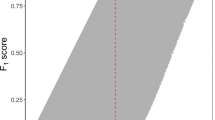Abstract
Predicting membrane protein type is a challenging problem, particularly when the query proteins may simultaneously have two or more different types. Most of the existing methods can only be used to deal with the single-label proteins. Actually, multiple-label proteins should not be ignored because they usually bear some special functions worthy of in-depth studies. By introducing the “multi-labeled learning” and hybridizing evolution information through Grey-PSSM, a novel predictor called iMem-Seq is developed that can be used to deal with the systems containing both single and multiple types of membrane proteins. As a demonstration, the jackknife cross-validation was performed with iMem-Seq on a benchmark dataset of membrane proteins classified into the eight types, where some proteins belong to two or there types, but none has ≥25 % pairwise sequence identity to any other in a same subset. It was demonstrated via the rigorous cross-validations that the new predictor remarkably outperformed all its counterparts. As a user-friendly web-server, iMem-Seq is freely accessible to the public at the website http://www.jci-bioinfo.cn/iMem-Seq.

Similar content being viewed by others
References
Chou KC (2001) Prediction of protein cellular attributes using pseudo-amino acid composition. Proteins 43:246–255
Chou K-C, Cai Y-D (2005) Prediction of membrane protein types by incorporating amphipathic effects. J Chem Inf Model 45:407–413
Chou KC, Elrod DW (1999) Prediction of membrane protein types and subcellular locations. Proteins 34:137–153
Chou K-C, Shen H-B (2007) MemType-2L: a web server for predicting membrane proteins and their types by incorporating evolution information through Pse-PSSM. Biochem Biophys Res Commun 360:339–345
Chou K-C, Zhang C-T (1995) Prediction of protein structural classes. Crit Rev Biochem Mol Biol 30:275–349
Chou K-C, Wu Z-C, Xiao X (2012) iLoc-Hum: using the accumulation-label scale to predict subcellular locations of human proteins with both single and multiple sites. Mol BioSyst 8:629–641
Deng J-L (1989) Introduction to grey system theory. J Grey Syst 1:1–24
Fasman GD (1989) Prediction of protein structure and the principles of protein conformation. Springer, New York
Fasman GD, Press C (1975) Handbook of biochemistry and molecular biology. CRC Press Cleveland, Ohio
Ginalski K, Elofsson A, Fischer D, Rychlewski L (2003) 3D-Jury: a simple approach to improve protein structure predictions. Bioinformatics 19:1015–1018
Huang C, Yuan J-Q (2013) A Multilabel model based on chou’s pseudo-amino acid composition for identifying membrane proteins with both single and multiple functional types. J Membr Biol 246:327–334
Kyte J, Doolittle RF (1982) A simple method for displaying the hydropathic character of a protein. J Mol Biol 157:105–132
Nanni L, Lumini A (2008) An ensemble of support vector machines for predicting the membrane protein type directly from the amino acid sequence. Amino Acids 35:573–580
Qiu J-D, Huang J-H, Liang R-P, Lu X-Q (2009) Prediction of G-protein-coupled receptor classes based on the concept of Chou’s pseudo amino acid composition: an approach from discrete wavelet transform. Anal Biochem 390:68–73
Radzicka A, Wolfenden R (1988) Comparing the polarities of the amino acids: side-chain distribution coefficients between the vapor phase, cyclohexane, 1-octanol, and neutral aqueous solution. Biochemistry 27:1664–1670
Schäffer AA, Aravind L, Madden TL, Shavirin S, Spouge JL, Wolf YI, Koonin EV, Altschul SF (2001) Improving the accuracy of PSI-BLAST protein database searches with composition-based statistics and other refinements. Nucleic Acids Res 29:2994–3005
Shen H-B, Yang J, Chou K-C (2006) Fuzzy KNN for predicting membrane protein types from pseudo-amino acid composition. J Theor Biol 240:9–13
Spiess M (1995) Heads or tails—what determines the orientation of proteins in the membrane. FEBS Lett 369:76–79
Wu Z-C, Xiao X, Chou K-C (2011) iLoc-Plant: a multi-label classifier for predicting the subcellular localization of plant proteins with both single and multiple sites. Mol BioSyst 7:3287–3297
Xiao X, Wu Z-C, Chou K-C (2011a) iLoc-Virus: a multi-label learning classifier for identifying the subcellular localization of virus proteins with both single and multiple sites. J Theor Biol 284:42–51
Xiao X, Wu Z-C, Chou K-C (2011b) A multi-label classifier for predicting the subcellular localization of gram-negative bacterial proteins with both single and multiple sites. PLoS One 6:e20592
Zhang M-L, Zhou Z-H (2007) ML-KNN: a lazy learning approach to multi-label learning. Pattern Recogn 40:2038–2048
Acknowledgments
This work was supported by the Grants from the National Science Foundation of China (N0. 31260273), the China- Montenegro Inter-Governmental S & T cooperation, the Province National Natural Science Foundation of JiangXi (No. 2010GZS0122), the Jiangxi Provincial Foreign Scientific and Technological Cooperation Project (No. 20120BDH80023), the LuoDi plan of the Department of Education of JiangXi Province(KJLD12083), and the Jiangxi Provincial Foundation for Leaders of Disciplines in Science(20113BCB22008). The funders had no role in study design, data collection and analysis, decision to publish, or preparation of the manuscript.
Author information
Authors and Affiliations
Corresponding author
Electronic supplementary material
Below is the link to the electronic supplementary material.
Rights and permissions
About this article
Cite this article
Xiao, X., Zou, HL. & Lin, WZ. iMem-Seq: A Multi-label Learning Classifier for Predicting Membrane Proteins Types. J Membrane Biol 248, 745–752 (2015). https://doi.org/10.1007/s00232-015-9787-8
Received:
Accepted:
Published:
Issue Date:
DOI: https://doi.org/10.1007/s00232-015-9787-8




